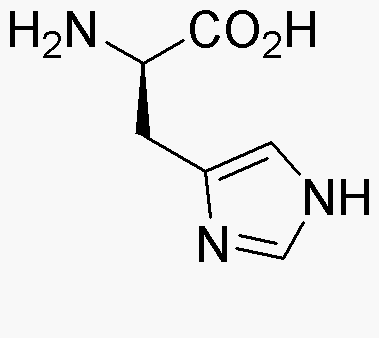D-Histidine is widely utilized in research focused on:
- Biochemical Studies: It plays a crucial role in studying enzyme activity and protein interactions, particularly in the context of metalloproteins and their catalytic mechanisms.
- Pharmaceutical Development: D-Histidine is explored for its potential in drug formulations, especially in targeting specific receptors in the body, enhancing therapeutic efficacy.
- Nutritional Science: Used in dietary supplements, it supports muscle recovery and overall health, making it popular among athletes and health-conscious individuals.
- Neuroscience Research: Investigated for its effects on neurotransmitter systems, it may contribute to understanding neurological disorders and developing new treatments.
- Cosmetic Applications: Incorporated in skincare products for its antioxidant properties, helping to protect skin cells from damage and promote a youthful appearance.
General Information
Properties
Safety and Regulations
Applications
D-Histidine is widely utilized in research focused on:
- Biochemical Studies: It plays a crucial role in studying enzyme activity and protein interactions, particularly in the context of metalloproteins and their catalytic mechanisms.
- Pharmaceutical Development: D-Histidine is explored for its potential in drug formulations, especially in targeting specific receptors in the body, enhancing therapeutic efficacy.
- Nutritional Science: Used in dietary supplements, it supports muscle recovery and overall health, making it popular among athletes and health-conscious individuals.
- Neuroscience Research: Investigated for its effects on neurotransmitter systems, it may contribute to understanding neurological disorders and developing new treatments.
- Cosmetic Applications: Incorporated in skincare products for its antioxidant properties, helping to protect skin cells from damage and promote a youthful appearance.
Documents
Safety Data Sheets (SDS)
The SDS provides comprehensive safety information on handling, storage, and disposal of the product.
Product Specification (PS)
The PS provides a comprehensive breakdown of the product’s properties, including chemical composition, physical state, purity, and storage requirements. It also details acceptable quality ranges and the product's intended applications.
Certificates of Analysis (COA)
Search for Certificates of Analysis (COA) by entering the products Lot Number. Lot and Batch Numbers can be found on a product’s label following the words ‘Lot’ or ‘Batch’.
Número de catálogo
Número de lote/lote
Certificates Of Origin (COO)
This COO confirms the country where the product was manufactured, and also details the materials and components used in it and whether it is derived from natural, synthetic, or other specific sources. This certificate may be required for customs, trade, and regulatory compliance.
Número de catálogo
Número de lote/lote
Safety Data Sheets (SDS)
The SDS provides comprehensive safety information on handling, storage, and disposal of the product.
DownloadProduct Specification (PS)
The PS provides a comprehensive breakdown of the product’s properties, including chemical composition, physical state, purity, and storage requirements. It also details acceptable quality ranges and the product's intended applications.
DownloadCertificates of Analysis (COA)
Search for Certificates of Analysis (COA) by entering the products Lot Number. Lot and Batch Numbers can be found on a product’s label following the words ‘Lot’ or ‘Batch’.
Número de catálogo
Número de lote/lote
Certificates Of Origin (COO)
This COO confirms the country where the product was manufactured, and also details the materials and components used in it and whether it is derived from natural, synthetic, or other specific sources. This certificate may be required for customs, trade, and regulatory compliance.


